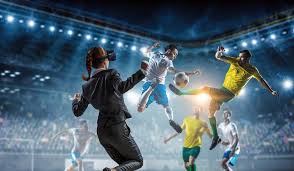The world of sports has undergone dramatic transformations over the past few decades, with technology playing a pivotal role in shaping the future of athletics. From the way athletes train and perform to how fans experience their favorite games, technology has revolutionized almost every aspect of sports. As we move forward, the integration of cutting-edge technology is set to further enhance performance, safety, and fan engagement in ways we can only begin to imagine.
In this article, we will explore how technology is influencing sports today and what the future holds for athletics in the years to come.
1. Smart Equipment and Wearable Technology
One of the most significant changes in sports has been the rise of smart equipment and wearable technology. These innovations are helping athletes improve their performance and monitor their health in real-time.
Wearables for Monitoring Performance
Wearable devices, such as fitness trackers and smartwatches, have become an essential part of many athletes’ training routines. Devices like Fitbit, Apple Watch, and WHOOP are not just used for tracking basic steps, but are equipped with advanced sensors to monitor heart rate, sleep quality, calories burned, and even stress levels. This data provides valuable insights that help athletes optimize their training and recovery, reducing the risk of injury and improving overall performance.
Smart Sports Equipment
Smart sports equipment, such as smart basketballs and sensors in tennis rackets, are also becoming more common. These devices track everything from spin rate and velocity to an athlete’s body mechanics. This allows coaches and athletes to make data-driven adjustments to improve technique and performance. The use of augmented reality (AR) and virtual reality (VR) in training, for example, allows athletes to simulate game situations, perfect their skills, and visualize their strategies in a controlled, high-tech environment.
2. Data Analytics and Performance Insights
Big data and advanced analytics have revolutionized the way coaches and athletes approach sports. By analyzing vast amounts of data collected during games and practice sessions, teams can identify trends, make strategic decisions, and even predict player performance under certain conditions.
Player Tracking and Game Analysis
Technologies such as player tracking systems (e.g., Catapult Sports and STATS) allow teams to collect data on player movement, speed, and positioning. This information is then analyzed to create detailed performance reports. For instance, in soccer, tracking the distance a player runs, the speed at which they run, and their positioning on the field can help coaches develop more effective strategies and provide personalized training programs.
Predictive Analytics in Sports
Another area where data analytics is making an impact is in predictive modeling. By using past performance data, teams can predict future performance trends and make more informed decisions about which players to recruit, how to structure training sessions, and when to rest athletes to prevent injury.
3. Virtual Reality and Augmented Reality in Training
Both virtual reality (VR) and augmented reality (AR) are revolutionizing training by providing athletes with an immersive experience that mimics real-game situations. These technologies are particularly useful in sports that require high levels of strategy and decision-making.
Virtual Reality Training
VR training programs allow athletes to simulate match conditions, such as facing an opponent or practicing tactics, without the need for physical space or actual opponents. For example, a football player can practice making critical game decisions under pressure by virtually stepping into a game scenario, giving them an edge when it’s time for the real thing.
Augmented Reality for Enhanced Coaching
AR is being used to overlay virtual information on the real-world environment, enhancing the coaching experience. For example, basketball coaches can use AR to show players where to position themselves on the court, highlighting ideal shooting angles or strategic plays in real-time during a practice session.
4. Sports Medicine and Injury Prevention
As sports continue to get more competitive, preventing injuries has become a top priority for both athletes and their teams. Technology has made great strides in sports medicine by improving injury prevention, diagnosis, and recovery.
Biomechanical Analysis for Injury Prevention
Advancements in biomechanics and motion capture technology allow doctors and trainers to analyze an athlete’s movements in detail. By identifying movement patterns that could lead to injury, coaches can make adjustments to improve posture, alignment, and technique, reducing the risk of long-term damage. This technology can also help monitor overuse injuries in athletes by providing real-time feedback on their performance.
Wearable Sensors for Injury Recovery
Wearable sensors are also helping with the recovery process. For example, devices like Korr Medical’s V02 Max sensors track an athlete’s oxygen consumption, helping medical teams create more personalized rehabilitation plans for injured athletes. These sensors provide feedback on the recovery process, ensuring athletes don’t push their bodies too hard too soon.
5. Fan Engagement and Viewing Experience
Technology is not just transforming how athletes train and perform; it’s also changing how fans experience sports. Enhanced fan engagement through technology is bringing fans closer to the action, whether they’re watching from home or the stands.
Live Streaming and Augmented Viewing
The use of live streaming platforms, such as ESPN+ and DAZN, has made it easier for fans to watch their favorite sports teams and athletes from anywhere in the world. Additionally, augmented reality (AR) is being integrated into live broadcasts to provide enhanced viewing experiences, such as real-time stats overlays, player tracking, and interactive features.
Fan Interaction Through Social Media and Apps
Social media platforms, apps, and interactive features allow fans to engage with their favorite athletes and teams like never before. Whether it’s through live Q&A sessions, voting for the Player of the Game, or sharing their thoughts on post-game analysis, fans can directly influence the sports experience. This has fostered a stronger connection between athletes and fans, contributing to the growth of sports in the digital age.
6. The Future of Technology in Sports
The future of sports technology looks incredibly promising. We can expect to see even more wearable devices, data-driven training tools, and virtual experiences that will continue to enhance the athletic experience for both players and fans.
From AI-powered coaches and autonomous vehicles that transport teams to games, to genetic testing that helps athletes optimize their performance at the DNA level, the sports industry is only beginning to tap into the potential of cutting-edge technology. As these innovations continue to evolve, we can expect sports to become even more dynamic, inclusive, and efficient.
Conclusion
The evolution of sports has been profoundly influenced by technological advancements, and as we look toward the future, it’s clear that technology will continue to play a crucial role in shaping the world of athletics. From improving performance and preventing injuries to enhancing the fan experience, technology is redefining the sports landscape. As these advancements continue, athletes, coaches, and fans alike will benefit from a more connected, efficient, and exciting sports world.
SEO Keywords:
- Evolution of sports
- Technology in sports
- Sports technology
- Wearable technology in sports
- Virtual reality in training
- Augmented reality in sports
- Sports data analytics
- Future of athletics
- Injury prevention in sports
- Smart sports equipment
- Player tracking technology
- Sports performance improvement
- Data-driven training
- Fan engagement in sports
- Sports medicine technology
- Virtual training in sports
This article is SEO-optimized with relevant keywords that can help it rank well for readers interested in the evolution of sports and technology’s impact on athletics. Let me know if you’d like any adjustments!

